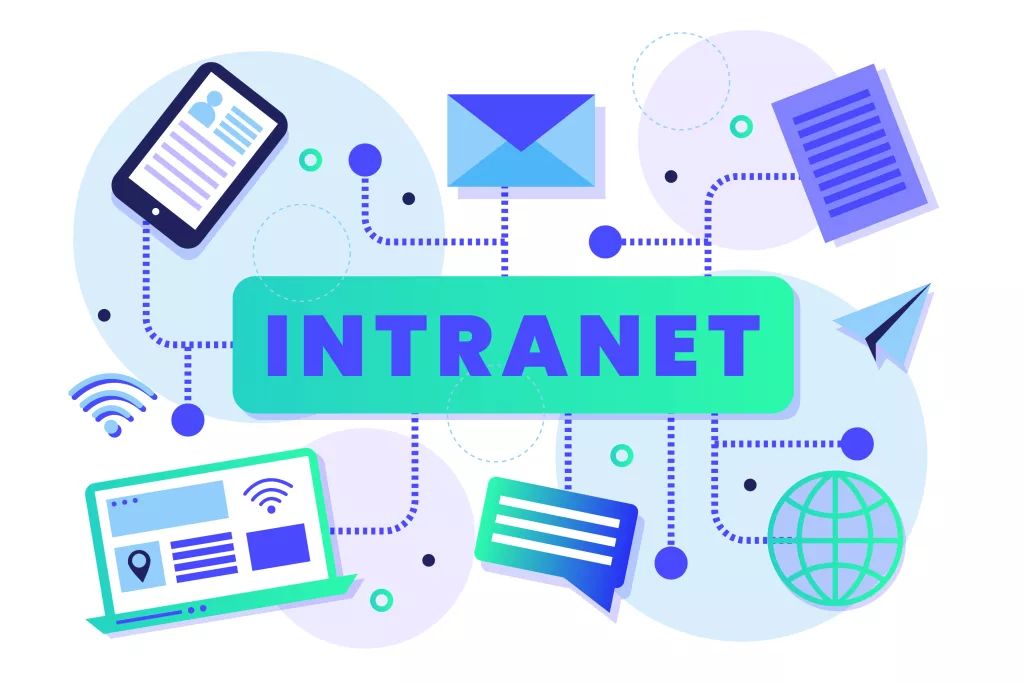In today’s fast-paced digital world, businesses are increasingly relying on technology to enhance communication and collaboration. One crucial tool in this realm is the intranet. But what exactly is an intranet, and why is it becoming an indispensable asset for organizations? In this blog post, we’ll explore the definition of an intranet, its benefits, and the features that make it a valuable resource for businesses of all sizes.

Definition of an Intranet
An intranet is a private network accessible only to an organization’s staff. It is designed to facilitate communication, collaboration, and the sharing of information within the company. Unlike the internet, which is open to the public, an intranet is secured behind firewalls and is accessible only to authorized users.
Intranets typically incorporate various technologies, including web servers, databases, and applications, to provide a centralized platform for information management and communication. This environment allows employees to access essential resources, tools, and information quickly and securely.

Benefits of an Intranet
1. Enhanced Communication
One of the primary advantages of an intranet is improved communication among employees. By providing a centralized platform for messages, announcements, and updates, an intranet ensures that everyone stays informed. This streamlined communication reduces the likelihood of misunderstandings and fosters a culture of transparency.
2. Increased Collaboration
Intranets facilitate collaboration across teams and departments. With tools like document sharing, real-time editing, and project management applications, employees can work together more efficiently, regardless of their physical location. This collaborative environment enhances teamwork and leads to more innovative solutions.
3. Knowledge Management
An intranet serves as a repository for important documents, policies, and resources. By organizing this information in a user-friendly manner, employees can easily access the knowledge they need to perform their tasks. This centralized approach to knowledge management helps prevent information silos and promotes a culture of sharing.
4. Improved Employee Engagement
A well-designed intranet can significantly boost employee engagement. Features like company news, employee recognition programs, and discussion forums foster a sense of community and belonging. When employees feel connected to their organization, they are more likely to be motivated and productive.
5. Enhanced Security
Security is a paramount concern for any organization, and intranets provide a secure environment for sensitive information. Access controls, encryption, and user authentication ensure that only authorized personnel can access confidential data. This level of security helps organizations protect their intellectual property and sensitive information from external threats.
6. Cost Efficiency
Implementing an intranet can lead to significant cost savings for organizations. By streamlining communication and reducing reliance on paper-based processes, businesses can lower operational costs. Additionally, the efficiencies gained through collaboration and knowledge management can lead to improved productivity and faster decision-making.

Key Features of an Intranet
To fully harness the benefits of an intranet, organizations should consider incorporating the following key features:
1. User-Friendly Interface
A user-friendly interface is crucial for ensuring that employees can navigate the intranet easily. Intuitive design and clear navigation menus enhance the user experience and encourage frequent use.
2. Search Functionality
Powerful search capabilities allow employees to find information quickly. An effective intranet should include a search bar that indexes all content, making it easy to locate documents, files, and resources.
3. Document Management System
A robust document management system enables organizations to store, organize, and share documents efficiently. Features like version control, access permissions, and file sharing promote collaboration and reduce confusion.
4. Communication Tools
Incorporating communication tools, such as chat applications, discussion forums, and announcement boards, helps facilitate real-time communication among employees. These tools can help create a sense of community and encourage engagement.
5. Employee Directory
An employee directory provides contact information and profiles for all staff members. This feature makes it easier for employees to connect with colleagues and fosters collaboration across departments.
6. Integration with Other Systems
To maximize efficiency, an intranet should integrate seamlessly with other business systems, such as project management tools, HR platforms, and customer relationship management (CRM) software. This integration streamlines workflows and provides a more cohesive user experience.
7. Mobile Accessibility
In today’s mobile-driven world, it’s essential for intranets to be accessible on various devices. A mobile-friendly intranet allows employees to stay connected and access information on-the-go, enhancing flexibility and responsiveness.
Conclusion
An intranet is a powerful tool that can transform how organizations communicate and collaborate. By offering a centralized platform for information sharing, enhancing employee engagement, and promoting collaboration, an intranet can lead to increased productivity and a more connected workplace. With the right features and a focus on user experience, businesses can unlock the full potential of their intranet and foster a culture of innovation and efficiency.
As organizations continue to evolve in the digital age, investing in a robust intranet is not just a smart choice; it’s a necessity for staying competitive and ensuring long-term success.


